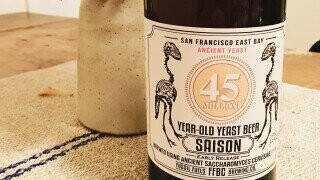Jurassic Park's Science Actually Works (To Make Beer)

In Jurassic Park, scientists source their dinosaur blood from mosquitos preserved in amber. Author Michael Crichton didn't invent this idea. In 1982, a Berkeley scientist published a paper about a dissecting a 40-million-year-old fly preserved in amber and discovering tissues and cells still ready for observation. Crichton conceived of his novel soon after that, and when Jurassic Park came out at the end of the decade, scientists were actively trying to extract amber-frozen bugs' DNA—that's what makes the story science fiction instead of just a dino fantasy.
In 1995, Raul Cano, who'd been studying microbes for decades, analyzed an ancient bee preserved this way. Its stomach contained no dinosaur blood. But its stomach did contain bacteria, and when Cano moved these bacteria to a nutrient medium, they came back to life, after having lain dormant for 25 million years.
This strain of bacteria had otherwise been long extinct, and no organisms still alive had natural defenses against it. Resurrecting it might sound dangerous, but it could also be useful and lucrative. Microbes, dangerous as some are, are also the source of antibiotics, our best defense against the really bad microbes. Cano founded a company to search for medical applications for his revived germs. The promising idea didn't pan out, the company shut down, and Cano moved on to unrelated research.
Don't Miss
Along with the bacteria, however, Cano had also resurrected an ancient strain of yeast, fairly similar to today's brewers' yeast. In 2006, one scientist who'd worked with Cano met a guy who owned a bar, who wondered if that yeast could make beer. Actually, they'd already tried that and had made a novelty batch of beer that way, even serving it to the cast of The Lost World. At the time, it hadn't seemed like a very appropriate application of this incredible process of theirs, but the bartender argued that if they could make beer using the yeast, they should.
Cano and the two other men got together and got to beermaking, now selling the result to the public. They used yeast that had been dormant for 45 million years now, yeast nearly from the time of the dinosaurs. They gave the new company a clever but very confusing name: Fossil Fuels Brewing Company.
Is the beer any good? One critic from the Oakland Tribune tried two varieties, one made with the ancient yeast and one made the exact same way but with conventional yeast. The normal beer was good enough. The ancient kind, however, had a "light copper color with an intense clove aroma, like a German heferweizen." Then, "just at the end of the finish, there was an intriguing, very odd spicy note." We're confident that's a positive review, and are all but certain that the last bit is NOT sinister foreshadowing about how imbibing ancient germs made him the dino zombie apocalypse's patient zero.
This fact came from the One Cracked Fact newsletter. Want more like this, straight from your email inbox, without any ads or popups? Join here:
For more beer science, check out:
The 7 Most Absurd Inventions in the History of Alcoholism
Drink Centuries-Old Booze (and Get Drunk Really Fast)
Your Body Might Brew Its Own Alcohol
Top image: Fossil Fuels Brewing Company
